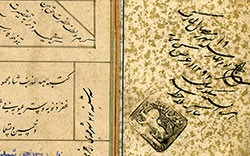Text and Margins
The relationship between the text and margin is noteworthy when the paper used for the text and the paper used for the margin are different.
Margins are generally distinguished from the text with thin lines, called borders or jadval. Depending on the fineness of the manuscript or book, it could have multiple margins of varying colors. In fine manuscripts and albums, the paper for the text and the margin are usually of a differing type and color. Sometimes, the text of a book would be written on two pieces of thin paper that were glued together so that there would not be a shadow from the text on the other side of the page. For this reason, the paper used for the margin of the page would often be twice as thick as the paper used for the text. When a single page was used to write on both sides, attention would be paid to choosing a paper with similar thickness with the text in order to avoid wrinkles.
This is usually done when the margin is damaged. A type of paper would be selected for the margin similar in color and thickness to the paper used for the text. This way, the book would close flat, and there would not be wrinkles that would allow air to sieve through the pages.
This method of attaching a new margin would have been done with utmost care so that the paper of the text and of the margin were edge to edge and did not overlap. Usually, the touching edges of the papers were then hidden from view with colored borders. Because of the considerable degree of expertise and effort required to create these kinds of pages, this technique is found only in the finest of manuscripts or albums.
In this piece, the thin outer borders in blue, black, and gold were likely drawn later since they overlap with the gold flecks on the surrounding page. The addition of these borders has the effect of distracting the viewer’s eye from the seam between the text and the margin.
Chalipā
This is a form of writing in which the lettering is not horizontal but written at a 45 degree angle. It is usually used for writing a couplet or a few verses of poetry in the Nasta‘liq script.
Symmetry
Symmetry is a common aspect of Islamicate arts, but at times slight varieties are embedded in seemingly symmetrical pieces, either for the sake of variety itself or because differing sizes of letters and words, which are out of the control of the artist, would disrupt the symmetry of the page. As such, despite their symmetrical appearance, there is rarely perfect symmetry in these works.



